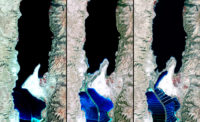

With financing agreed between Israel and one of its largest corporations, preliminary planning has begun on an estimated $600-million project to build what could be one of the world's longest conveyors. It will carry dredged salt and silt out of the southern Dead Sea to prevent flooding of more than a dozen seaside hotels.
Israel Chemicals Co. has agreed to pay 80% of the cost to build an estimated 36-kilometer conveyor, which will carry dredged material to the sea's northern end for dumping, and acquire three dredges. The huge salt pond has built up from years of potash extraction by the company's Dead Sea Works subsidiary. Silt contained in the mineral-rich water transported by canal to the south for mining also is cited for the buildup that has caused the sea-level rise threatening the hotels.
A soil levee now provides a temporary barrier. Several remedial options were considered, including hotel relocation. The Dead Sea is 67 km long.
In January, Israel Chemicals and the Israeli government agreed on the dredging program, which was supported by most local environmental groups. The firm agreed to pay $90 million a year in annual operating costs through 2030, with part of its contribution coming from increased potash production royalties. The government will pay the remaining 20%. Dead Sea Works was privatized in 1995.
Due to the project's complexity and the lack of local expertise, most detailed planning, construction and equipment will be supplied by foreign companies, officials say. "The soil conditions and terrain along the Dead Sea shore present planners with major difficulties," says Yuval Dvoskin, Dead Sea Works engineer and project manager. He says the conveyor route will be close to the western shore of the Dead Sea, the lowest land point on earth, about 420 meters below sea level. The area has extremely soft soil and is prone to sudden sinkholes.
"The conveyor belt will handle 20 million tons of salt annually at a rate of 4,000 tons per hour," says Dvoskin. Options to use barges or slurry are being considered for dumping the huge quantities of salt back into the sea's northern basin, where it will sink to the bottom and present no risk.
"We expect to finish the preliminary planning by the end of 2013 and complete actual construction in 2016," says Noam Goldstein, senior vice president at Dead Sea Works. From the time that salt dredging begins, it will take two years until the water level reaches a steady state and ceases to threaten the hotels, Goldstein adds.


Post a comment to this article
Report Abusive Comment